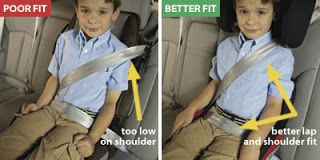
Child Safety Seats Have An Expiration Date
October 14, 2011
In these hard economic times, when parents have a new child on the way, it is often tempting to use a hand-me-down child safety seat or a used child seat purchased from a second hand store but, did you know that child safety seats have expiration dates?
It is a little known fact that child safety seats have expiration dates; usually six years from the manufacture date. There is a very good reason for this. Child safety seats are made from synthetic, petroleum based plastics and fabrics. While these materials are excellent for this purpose and make for a very strong and reliable child protective seat, they are subjected to a lot of harmful environmental factors that can weaken them over the years.
Most child seats remain in the car and internal temperatures inside the car in the summer can easily reach 130 to 140 degrees and over time, this can lead to a breakdown of the plastic materials. Exposure to the sun is also harmful. Synthetic fabrics, especially nylon don’t tolerate long periods of direct exposure to the sun very well. When exposed to the sun over long periods, the synthetic fabrics can become brittle and break; not something you want a safety belt to do.
Read more about: Summer Heat Warnings – Never Leave Children Alone in Cars
So, while a used seat may look perfectly fine, there may be damage that is too small to see that can grow over time. Your little passenger is too precious to take that chance. Most seats have the expiration date embossed in the plastic on the bottom of the seat. When considering a used car seat, check the expiration date and make sure that your child will have outgrown it before it expires.
Parents should also remember that children who outgrow the child safety seat should graduate into a booster seat until they are at least 4’9” tall. Lots of kids are graduated to seat belts too early and their small frames prevent the seat belt from fitting properly low over their hips. If the belt should rise up over their abdomen, they could be injured in a crash.
For more information on child safety seats and booster seats, visit the Insurance Institute for Highway Safety at: http://www.iihs.org/research/topics/child_restraints/default.html
For help in learning how to properly install and use a child seat, the National Highway Traffic Safety Administration has a web site that can direct you to a trained Child Passenger Safety Technician in your area who can teach you how to install your seat, answer any questions you may have, and give you additional information on child safety seats. To locate a Child Passenger Safety Technician, visit: http://www.nhtsa.gov/cps/cpsfitting/index.cfm
Photo: Compliments Insurance Institute for Highway Safety

Make your Trip to School a Safe One
October 5, 2011
Word’s out: summer’s officially over. Other than the nationwide-groans from kids, there’s also something else to be concerned about: children’s safety. These kids may be in their preschool years, or they may be at the driving age — bottom line is: pedestrian safety is a still a genuine concern.
Here are some tips both for parents and children to make their daily trip to school a safe one:
- Parents should have a talk with their children regarding safety. For the younger kids, parents should be giving out more specific advice than “don’t talk to strangers.” These talks can and should also include the following topics: looking left to right before crossing, crossing/getting off the bus only where it is allowed or with adult supervision and numbers to call should they find themselves lost. For the older kids, maybe it’s time to introduce a Parent-Teen Driving Contract — to put down in paper what is specifically not allowed in the scope of their driving privilege/responsibility.
- Drive carefully. Be the example for your children. Always buckle your seat belt before driving, remove all distractions from the vehicle and always obey traffic signs or lights. Always keep the vehicle maintained so it doesn’t break down and the kids (or you!) won’t get late.
- If the school is within walking distance from the home, parents should survey the route their children take. Is there a “walking school bus” (a group of kids on their way to school accompanied by an adult from the neighborhood) near the area where you live?
- For parents and teen drivers: always be aware of school zones. The penalties of going too fast or driving up where you’re not supposed to is even greater than when you’re on the road — even worse, you may get in an accident. Remember that there is a speed limit of 25mph in school zones which apply before and after school hours.
- Have fun: school may end up being the best time for children, and a fond memory for parents. Making sure you and your family is safe ensures that you’ll cherish the moment more.

Child Passenger Safety Week / Seat Check Saturday
September 1, 2011
Child Passenger Safety Week is coming up September 18 – 24 and there are a few issues to be aware of as we think about how to best protect the most precious cargo of all.
A small but interesting study by the Yale School of Medicine’s Department of Pediatrics revealed that large number of children are unbuckling themselves from their child safety seat while the car is in motion, making their risk of injury in a crash up to three and a half times greater. What is remarkable is that some of those children who unbuckle themselves are as young as 12 months old.
According to the Yale press release, “The team found that 75% of children who self-unbuckle were age three and under, with an age range of 12 to 78 months. Unbuckling was reported as early as 12 months of age and was more common in boys than girls. Of the children self-unbuckling, 43% did so while the car was in motion. Twenty-nine percent of children who unbuckle are in a five-point restraint and do so more commonly from the chest buckle. The most common parental response to self-unbuckling while the car was in motion was “pull over, reprimand, and re-buckle the child.”
If you, as a parent or grandparent, find your toddler unbuckling their seat belt, don’t try to deal with it while the car is in motion. The safest possible action is to slow, find a place to pull over as quickly as possible and then, reprimand and re-buckle your child; trying to deal with the situation while the car is in motion puts both of your lives at risk.
In an article on this study in WebMD.com, Lorrie Walker, training manager and technical advisor for Safe Kids USA, an advocacy group was quoted as saying; “This study raises questions about how the child restraint was used,”. She went on to say that “Federal motor vehicle safety standard 213 requires the buckle to release using between 9 and 14 pounds of pressure. It is often challenging for an adult to unbuckle the harness.” She wondered if the buckle wasn’t adequately locked in some of those cases.
The National Highway Traffic Safety Administration (NHTSA) estimates that as many as three out of four parents aren’t installing their child safety seat correctly. If you have doubts about whether or not you are properly buckling the harness or whether or not the child safety seat is installed correctly, there is a service that you can use to get training and guidance on the proper use of a child safety seat. NHTSA has a website called the “Child Safety Seat Inspection Station Locator“. In this site, you can plug in your state or zip code and find technicians who can show you how to properly install and use the child safety seat. These Child Passenger Safety Technicians receive training and certification based on a standardized nationally recognized curriculum.
Using the Child Safety Seat Inspection Station Locator, you can find a nearby Child Passenger Safety Technician, usually at your county’s Department of Public Safety or the local police or fire department. You will need to make an appointment with the technician and allow about 20 minutes to complete the training. Expectant parents should schedule an appointment about three weeks before their child’s due date. This is a free service.
You should remember also that child safety seats aren’t just for babies and toddlers. The Insurance Institute for Highway Safety has determined that children are being graduated from child safety seats to seat belts too early. In small children, instead of resting low over their hips and pushing against their hip bones, the seat belt tends to ride up over their abdomen where it can cause internal injuries in a crash. Children who graduate out of child safety seats should move into a booster seat until they are at least 4’9” tall or anywhere from 9 to 11 years of age.
While talking about car seats, it is important to remember never to leave your child unattended in a car. Even when the outside temperature is cool, the temperatures inside a car can quickly rise up to more than 100 degrees on a sunny day. Kids and Cars.org estimates that, on average, 38 children die in hot cars each year from heat-related deaths after being trapped inside motor vehicles.
Yellow Dot Program Saves Lives
June 3, 2011
A new, low cost, program for saving lives is slowly popping up in counties throughout the United States. Known as the “Yellow Dot Program” this innovative program alerts first responders to a vehicle crash about the driver’s medical information including any medications that the driver may be taking. This information can be critical to a severely injured crash victim during the first “golden hour” of emergency treatment that determines whether a crash victim will survive or not.
The program consists of a simple yellow dot decal fixed to the driver side rear window of a vehicle. The yellow dot notifies emergency personnel that there is a folder in the glove compartment of the vehicle that contains important medical information about the driver. Typically, the folder includes a photo of the driver along with the driver’s address and emergency contact information. The folder also includes information about any health issues the driver may have and a list of medications that the driver may be taking along with the names and contact information for the driver’s doctors.
Knowing that the driver may have health problems, such as a heart condition and the medications a driver may be taking, allows first responders to make important decisions regarding emergency treatment. Knowing in advance that the driver is taking a particular medication that could react adversely with drugs normally given in the emergency room can make the difference between life and death for the patient.
The Yellow Dot Program started in Connecticut and has since spread to eight other states including Kansas, Illinois, Iowa, Minnesota, Massachusetts, Virginia, Alabama and New York. Each state’s program is essentially the same with slight variations from state to state. Initiated mostly at the county level, the program is catching on quickly and rapidly gaining approval of emergency medical personnel.
If your state or county does not have this Yellow Dot program, you may want to consider contacting your local representatives to see about getting one started. It could save your life.
Image: http://adeca.alabama.gov

Maggie’s Law: New Jersey Drivers Aren’t Drowsy
November 12, 2010
Maggie’s Law is a unique law that exists only in the state of New Jersey. It is a law that drivers must not knowingly operate a vehicle while impaired by lack of sleep. Should they cause a fatality, drivers who lack ample rest may be prosecuted for vehicular homicide. Other states like New York, Illinois and Kentucky are considering similar laws.
Having been passed in 2003, the National Sleep Foundation says, “This is the first law of its kind in the U.S.” With reports about drowsy driving, it’s easy to point out that it could be as bad, or even worse than driving under the influence, yet there aren’t too many laws like Maggie’s law that make it illegal.
A couple of weeks ago, New Jersey was identified as one of the states that had the lowest number of teen fatalities. A strict Graduated Driver’s Licensing program and legislation like Maggie’s law may be pointed out as a reason for this. While there isn’t a test yet that will be able to prove if a driver was indeed impaired by lack of sleep, the National Highway Traffic Safety Administration gave a $1 million dollar contract to the University of Iowa for the development of such a device, but it’s a safe assumption that it would take years until that becomes a reality.
While “drowsy driving,” isn’t quite outlawed yet in all parts of the country, agencies like the National Sleep Foundation, NHTSA and AAA are giving out advice in order to overcome rest-deprived fatigue:
- Get plenty of rest the night before. At least 6 hours of sleep.
- For longer trips, schedule a break every two hours, or every 100 miles.
- Drive during the times when the driver is normally awake, and choose to sleep in overnight instead of powering on through the night, driving.
- Stop driving when a driver feels that he is sleepy, or exhibiting signs of fatigue.
- Take turns driving with a designated driver (for when you are sleep-deprived).
- If taking medication: take note of the side effects of medicine. Some medications have side effects that include drowsiness.
